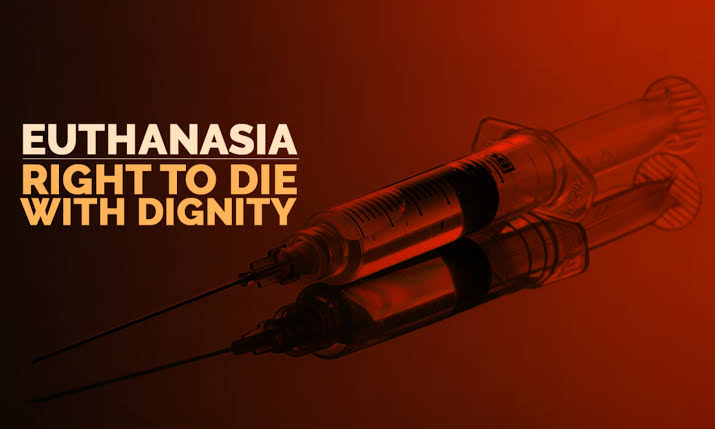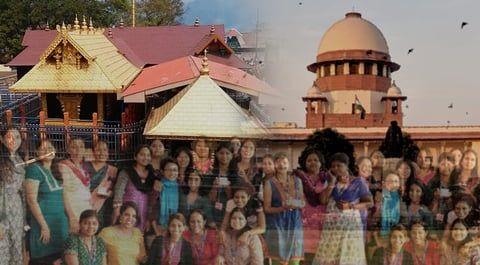An Exercise on Euthanasia

Background: Karen Ann Quinlan:
The story of an American women started the legal debate on Right to die. The case was 1st of its own kind, Karen a 21-year-old woman graduated from her school joined college and worked. She bought a dress and in order to fit into it, she fasted for 3 complete days. She consumed Valium along with alcohol while she was in her crash diet. Which led her into an unconscious state, doctors stated that she entered into a vegetative state, with this her parents made an application requesting, to remove the feeding and respiratory tubes but when you remove it can be considered as manslaughter under roman catholic laws it shall amount to Homicide. So, her parents filed a petition in New jersey District court, requesting the withdrawal of respiratory tube alone, which can give her a natural death.
- The petition was first filed in New jersey, District court. Then it was filed in, the new jersey superior court, then finally in the supreme court.
- The New jersey supreme court, allowed the hospital to withdraw respiratory tube, and she survived for 9 years. Later on due to pneumonia she suffered a respiratory failure and died.
ARUNA SHANBAUG V. UNION OF INDIA
“EVERY PERSON IN THIS WORLD COMES CRYING, HOWEVER THAT PERSON WHO LEAVES THE WORLD SMILING WILL BE THE LUCKIEST OF ALL”
Facts of the case:
Aruna Ramachandra Shanbaug, was a staff nurse at KEM Hospital, Mumbai. On 27th November 1973 Aruna was attacked by a ward boy of the hospital. He wrapped her neck using a dog chain and attempted to rape her. Finding her menstruating, he sodomised her. The next day she was seen lying on the floor in an unconscious state on a pool of blood. As the chain was wrapped around her neck, the blood flow to the brain was stopped. She was also suffering from bed sores and was in a PVS persistent vegetative state, and her brain is virtually dead. The ward boy was held accountable for theft, and murder attempt as he stole the earrings and watch of Aruna. There was not even a slightest possibility of her recovery and she was in the state from 36 years in the KEM Hospital of Mumbai. A writ petition was filed before the apex court by an eminent journalist and activist, Ms. Pinki Virani claiming to be the next friend of the patient. The petitioner prayed in front of the apex court to stop the force feeding for the patient, and let her die peacefully.
A counter affidavit was filed on behalf of the respondents, which varied from the petition. Due to the variance in the allegation the court ordered a team of three distinguished doctors to examine the patient. The report stated that, “Aruna has evidence of enact auditory, visual, somatic and motar stimuli, she was responding to the surroundings and is expressing her likes and dislikes on food that was supplied”. Hence the apex court decided to take up the matter.
Issues raised:
- whether the life-supporting system of a person should be withdrawn in order to protect the right to live with dignity, and if that should be backed by Law?
- Whether the next friend of the patient can file the petition to withdraw the life supporting system of the patient, if he/she is not in the state to file the petition?
- Whether the Journalist Pinki Virani should be considered as the next friend of the Patient or the KEM hospitals?
Reasoning and Analysis:
Arguments of the petitioner:
- Pinki Virani, on behalf of Aruna asked for legalization of the Euthanasia, so that Aruna’s continued sufferings can be ended with the withdrawal of medical support.
- Contented that, Life is not merely an Animal existence but a living a healthy life with dignity. Right to life means the right to lead meaningful, complete and dignified life.
- Further, they relied on the case of Gian Kaur v State of Punjab and stated that the
Right to die is a part of the Right to Life with dignity under Article 21 of the Indian Constitution.
- Pinki Virani, appealed that she was the closest friend of the patient hence shall be a next friend. As most of her relatives are either dead or abandoned her.
- Aruna has no chance of recovery, and the person should be relieved from the pain and agony by Passive Euthanasia. Aruna had been blocking a bed in a country where a high-grade medical facility is still a distant dream and a luxury for few. Therefore, such expenditure on Aruna is going in vain, where there is no minimal chance of recovery.
Arguments of the respondent:
- The respondent, KEM hospitals have contended the granting of euthanasia, stating that all the staff has a certain bonding with Aruna, and they are happy enough to serve her. If euthanasia is allowed all their efforts shall go in vain.
- On behalf of the Union of India, the hospitals stated that it would be inhuman to cut down the life supporting system and it shall also be a violation to the human right. And every person in India as right to live in the state {pvs} in which they reside.
- The counsel also made it a point on the misuse of the law, because though Indian society is a care oriented and emotional it is equally greedy and cunning. Hence there shall be greater danger in view of the relatives on the issue of property inheritances.
- The next major contention is that in the view of fast developing world, medical field is also very rapidly upgrading in the quality of medicine and treatment. So, there shall be a space when, there shall be a treatment for the present condition.
- The respondent also contended that, the petitioner has no locus standi as the hospital is the next friend for the patient and not the petitioner.
Analysis:
The court discussed varied spectrum of aspects, from the right to die under right to life to differentiation from passive and active euthanasia. Ethical, moral, philosophical and legal perspectives were analyzed by the court. In State of Maharashtra v. Marutya Shripati Dubal court held that the section 309 {Attempt to commit suicide} of IPC is violation of the article 19 and 21. It was held that Right to die is enclosed in the ambit of right to die, striking down the Section. Right to die is not unnatural but is just uncommon and abnormal.
In Rathinam v. Union of India court held that Right to die is included in Article 21. In Gian kaur v. state of Punjab, there was a constructive overruling of the above Rathnim case and validating the section 306 of IPC {penalizing the abetment of suicide} the court clarified that, the right to die is not a context of the termination of life permanently, but rather an accelerating process of death which has already commenced. Court has also submitted that, the right to live with human dignity must also include a death with dignity. Court have also noted in Gian kaur v. state of Punjab, that Right to life under Article 21 doesn’t include right to die, but the right to live with dignity includes the right to die with dignity.
In Aruna Shanbaug’s case the court recognized two forms of euthanasia, active and passive and it was noted that active euthanasia shall not be permitted. Thus, insofar as active euthanasia is concerned, this has to be treated as legally impermissible, at least for the time being. It is more so, as there is absence of any statutory law permitting active euthanasia. If at all, legal provisions in the form of Sections 306 and 307 IPC etc. point towards its criminality. The decision in Aruna Shanbaug distinguishes between active and passive euthanasia. Active euthanasia is defined as the administration of a lethal substance or force to kill a person, such as for instance, a lethal injection given to a person suffering from agony in a terminal state of cancer. PART D 23 Passive euthanasia is defined to mean the withholding or withdrawing of medical treatment necessary for continuance of life. This may consist of withholding antibiotics without which the patient may die or the removing of the patient from artificial heart/lung support.
Evaluation:
- Airedale NHS Trust v. Bland: – House of Lords
It was the first time in the English history that right to die was allowed through withdrawal of life support systems including food and water. The authority was conferred on the court to decide on, if the patient is fit for euthanasia or not. After varied view points of the jurist, it was opined by Lord goff, that the distinguishing between “how life support can be differentiated from ending a patient’s life by a lethal injection
Lord Goff, stated that the acts of the doctors should be in the best interest of the patient, (subject to the patient’s ability to give or withhold its consent.) Thus, it was settled in the case of Airedale that it was lawful for the doctors to discontinue treatment if the patient refuses such treatment. And in case the patient is not in a situation permitting him to communicate his wishes, then it becomes the responsibility of the doctor to act in the ―best interest of the patient.
In the context of sanctity of life, there are three different viewpoints that are presented in Airedale case. i.e there are at least three different viewpoints in the decision on the moral position of suicide.
- A desire to die can only result from an overpowering negative impulse, arising from a perceived incapacity failure or pain. This is an extreme state which is unlikely to be shared by the third party that assists. A high degree of professional objectivity is at stake.
- Whatever right a person might have to put an end to his own life depends on the principle of autonomy, which leaves the disposal of life to him. The right of a third party to assist cannot depend on that principle. The choice made by the person to kill himself is morally the same, whether he does it because he is old or terminally or because he is young and healthy but fed up with life. In both the cases the choice made by them is equally justified, but to a third eye who intervenes to help them is different.
- The involvement of the third party raises the problem of the effect on the other vulnerable people which the unaided suicide doesn’t. if it is lawful for a third party to encourage or assist a person in suicide of a person chosen death in a clear head free from external pressures, for him to encourage or assist others who are in less good position to decide.
- Gian kaur v. State of Punjab:
Gian Kaur’s case held that the “right to life: including right to live with human dignity” would mean the existence of such right up to the end of natural life, which also includes the right to a dignified life upto the point of death including a dignified procedure of death. Gian Kaur’s case did not express any binding view on the subject of euthanasia. We hold that no binding view was expressed by the Constitution Bench on the subject of Euthanasia.
- International considerations and decisions of the European Court of Human Rights (ECHR)
- The following rights in the ICCPR are considered have been considered by the practice of voluntary euthanasia. Right to life (Article 6), freedom from cruel, inhuman or degrading treatment (Article 7). Right to respect for Private life (Article 17), freedom of thought, conscience, and religion (Article 18).
- Comments from the UN Human Rights Committee suggest that laws allowing for voluntary euthanasia are not necessarily incompatible with the States‘ obligation to protect the right to life.
Synthesis:
Judgement: the court looked in to the matter of the brain death in order to decide the case, Brain death may be defined as, “the irreversible cessation of all functions inside the entire brain including the brain stem. The question of death has many legal consequences. In Aruna Shanbaug’s case court relied on the doctor’s report and as per the definition of the brain death according to Transplantation of human rights act, 1994. Aruna was not brain dead. Her condition was stable in a sense, that she could maintain the breath without life supporting mechanisms and she was responsive towards the circumstances. Therefore, Aruna Shanbaug was denied passive euthanasia as she was not fit for the same, court suggested that if at any time in the future the hospitals KEM can approach the high court and follow the prescribed procedure.
Supreme court issued a set of broad guidelines legalizing passive euthanasia in India. Court held that right to die is nor against nature but only unusual. Then SC acknowledged that, Article 21 not only includes Right to life but also includes Right not to live(life). Finally, the court allowed for passive euthanasia under exceptional circumstances under Strict guidelines laid down by the court.
- As there is no statutory provision on the legal procedure to withdraw the life support system the law made by the court shall be law till the parliament makes any legislation in that regard.
- A decision can be taken by the parents, relatives, spouse, next friend, or the doctors who are attending the patient, they must decide in the best interests of the client.
- Any decision shall require the approval of the high court. Though Indian society is a care oriented and emotional one, it can be sometimes cunning and greedy, and can conspire into any un ethical act for the sake of material benefits (acquisition of some land and property of the diseased). That is where court has discretion to maintain the patient at his best interest.
- Thus, on these few grounds the SC has allowed passive euthanasia under certain circumstances and requiring the high court to follow the due process of the law. As in when an application is filed before the chief justice of the high court, the court must constitute a 2-judge bench and assign them to look into the merits of the case in coherence with the expert doctor reports.
The Supreme Court did not accept Pinki Virani as the “next friend” but awarded guardianship to KEM hospital staff on the ground that they had “an emotional bonding and attachment” to Aruna Shanbaug and were her “real family.
Conclusion:
Due to few inconsistent opinions in Aruna Shanbaug’s case v. union of India and in Gian Kaur v. state of Punjab the matter was further referred to a larger bench of Supreme court. In 2018, guidelines were issued and principles were laid down. The court specially stated that, the dignity in the process of dying is as much a part of the right to life under Article 21. To deprive an individual of dignity towards the end of life is to deprive the individual of a meaningful existence.
The 241st report of the law commission of India on the passive euthanasia
It dealt with the Passive Euthanasia- A relook: Justice Cardozo states that, in case of any forced medical intervention on the body of a patient the doctor shall be guilty of assault.
The report rightly points out that a rational and humanitarian outlook should have primacy in such a complex matter. The report in upholding the patient’s autonomy went on to state, 1. The patient has right to refuse medical treatment resulting in temporary prolongation of life.2. one would like to protect his right to privacy protected which implies protection from interference and bodily invasion. 3. No law can inhibit a person from opting the euthanasia as it is not comparable of suicide. 4. The doctor or relatives cannot compel the patient to have invasive medical treatment by artificial means or treatment.
Thereby, court observed that the “the law, therefore in a changing society march in tune with the changing ideas and ideologies” law gladly takes cognizance of the fact that, dignity is the most sacred position of the man and the said position neither loses its sanctity in the process of the dying nor evaporates when death occurs.
Social morality, medical ethicality and state’s interest.
society at large may feel that a patient should be treated till he breathes his last breath and the treating physicians may feel that they are bound by their Hippocratic oath which requires them to provide treatment and save life and not to put an end to life by not treating the patient. At times the situation can have an adverse allegation on the doctor or surgeon for negligence and criminal culpability.
First, withdrawal of treatment in an irreversible situation is different from not treating or attending to a patient and second, once passive euthanasia is recognized in law regard being had to the right to die with dignity when life is ebbing out and when the prolongation is done sans purpose, neither the social morality nor the doctors‘dilemma or fear will have any place.
Therefore, finally after the writ petition “common cause v. Union of India and anr” the legal stance of euthanasia is clarified.
“Death is our friend … he delivers us from agony. I do not want to die of a creeping paralysis of my faculties – a defeated man.” – Mahatma Gandhi
Author: Chandanasriya.k, a Student of Damodaram Sanjeevaya National Law University




Very good information and correct presentation